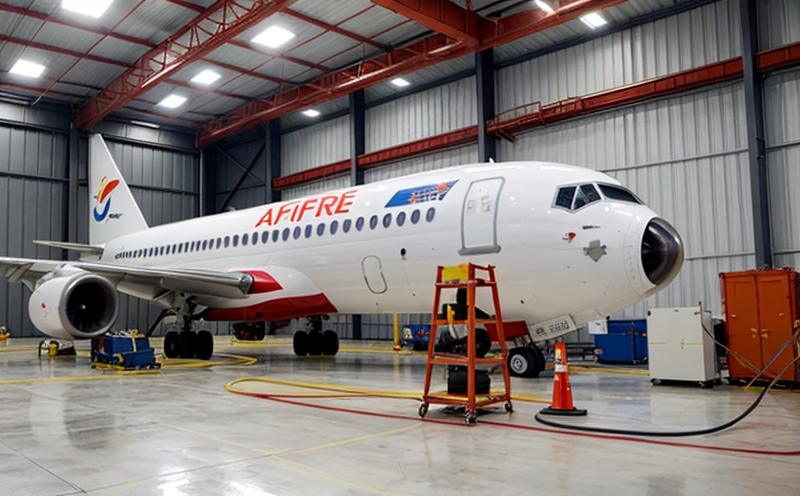Heat and Smoke Release Analysis for Aerospace Materials
The aerospace industry is a highly regulated sector that demands stringent standards to ensure safety, reliability, and efficiency. Within this context, heat and smoke release analysis plays an essential role in ensuring the materials used meet critical fire safety requirements.
Heat and smoke release analysis evaluates how much heat and smoke are produced by materials when exposed to specific test conditions. This is crucial because it helps determine whether a material will contribute significantly to the spread of flames or produce excessive amounts of toxic fumes, both of which can be hazardous in an aerospace environment.
The primary objective of this service is to provide detailed information on the heat and smoke release characteristics of materials used in aircraft interiors. By conducting these analyses, we ensure that manufacturers adhere to international standards such as ISO 1968 and ASTM E662-14, which are designed specifically for assessing fire behavior.
During testing, specimens undergo rigorous evaluation using advanced equipment like the Cone Calorimeter and Smoke Release Analyzer. These instruments measure the calorific value (MJ/m²) of gases released during combustion as well as the rate of heat release (W/m²). Additionally, they assess the smoke production index (SPI), which quantifies the amount of visible smoke generated.
Specimen preparation is a critical step in this process. Samples must be cut to standardized dimensions and prepared according to specified protocols prior to testing. This ensures consistency across all samples being analyzed so that accurate comparisons can be made between different materials or versions of the same material over time.
The results from these tests are then compiled into comprehensive reports providing detailed insights into each material’s fire performance characteristics. These reports serve several purposes including aiding in design decisions, supporting regulatory submissions, and ensuring compliance with relevant aviation standards like FAR 25.853 or ETSO P170.
By offering this service, we contribute significantly to the ongoing efforts towards improving passenger safety within commercial air travel by identifying potentially problematic materials early on in their development cycle through proactive testing practices.
Why It Matters
The importance of heat and smoke release analysis cannot be overstated given its direct impact on aviation safety. In the event of a fire onboard an aircraft, effective measures to contain it are vital for minimizing injuries and preventing loss of life. Materials used inside cabins must perform optimally under such circumstances; they should neither fuel nor exacerbate fires nor produce excessive amounts of harmful gases.
Compliance with regulatory requirements is another significant reason why this analysis matters greatly. Governments around the world enforce strict regulations aimed at ensuring that all components within aircraft interiors meet certain safety thresholds. For instance, European Union Aviation Safety Agency (EASA) and Federal Aviation Administration (FAA) both require manufacturers to demonstrate compliance with specific fire performance criteria.
From an operational perspective, knowing exactly how materials will behave in case of a fire allows airlines to make informed choices about which products to specify for their fleets. This knowledge can help reduce risks associated with certain materials that might not perform well under stress conditions. Furthermore, it supports efforts towards continuous improvement by identifying areas where current standards could be enhanced or updated based on new findings from research and development activities.
Lastly, there is an increasing awareness among stakeholders about the environmental impact of manufacturing processes and end-of-life disposal practices. By understanding how materials contribute to fire safety performance, manufacturers can work toward creating more sustainable alternatives that minimize adverse effects on both human health and ecosystems while still maintaining high levels of performance.
Quality and Reliability Assurance
The quality and reliability assurance processes associated with heat and smoke release analysis are designed to ensure consistent, accurate results across multiple tests. This involves several key steps:
- Standardized Specimen Preparation: Ensuring that every sample cut follows precise guidelines helps maintain uniformity between different batches of material being tested.
- Calibration and Validation: Regular checks on the performance of testing equipment guarantee they remain accurate throughout their operational lifespans. This includes periodic recalibrations against certified reference standards whenever necessary.
- Data Analysis: Utilizing sophisticated software tools allows for detailed analysis of collected data points, enabling identification of trends and anomalies that may indicate potential issues with tested materials.
These rigorous quality control measures not only enhance the credibility of our findings but also foster trust among clients who rely on us to deliver reliable information about their materials' fire performance characteristics. By adhering strictly to established protocols, we ensure consistent outcomes that can be confidently used in decision-making processes related to aviation safety.
Environmental and Sustainability Contributions
Beyond enhancing passenger safety, heat and smoke release analysis also contributes positively towards environmental sustainability goals set forth by various organizations worldwide. Here are some ways this service supports these objectives:
- Material Selection: Understanding the fire behavior of different materials allows manufacturers to select those that offer superior performance without compromising on eco-friendly attributes like recyclability or biodegradability.
- Innovation and Development: Insights gained from these tests encourage innovation in developing new, safer alternatives that are also environmentally friendly. This promotes a circular economy where waste is minimized and resources are efficiently utilized throughout the lifecycle of products.
- Regulatory Compliance: Meeting stringent environmental regulations helps minimize negative impacts on air quality both during production phases and when materials reach end-of-life stages.
In summary, by providing accurate data regarding heat and smoke release properties, we assist our clients in making environmentally responsible choices that ultimately benefit society as a whole. Our commitment to sustainability extends beyond individual projects; it forms part of our broader mission to contribute towards creating safer, greener skies for future generations.





